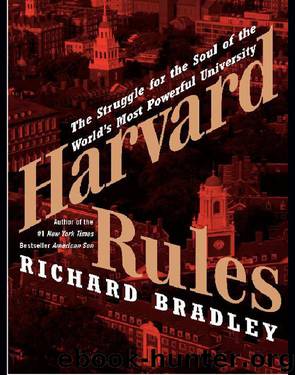Harvard Rules by Richard Bradley

Author:Richard Bradley [Richard Bradley]
Language: eng
Format: epub
ISBN: 9780061744921
Publisher: HarperCollins
Published: 2005-11-30T05:00:00+00:00
Over the course of the twentieth century, as the number of Jews attending Harvard grew, the university compiled a distinctly uneven history of tolerance and acceptance. To put it another way, Harvard first tolerated Jews, then discriminated against them, and finally welcomed them—until Jews were clearly such a vital and powerful influence upon the university that discriminating against them was not only morally intolerable, but, as a practical matter, impossible.
The first Jews to attend Harvard in large numbers arrived during the presidency of Charles W. Eliot, in the latter half of the nineteenth century and the first decade of the twentieth. As evidenced by his abolition of required courses, Eliot had a broad and open mind and little patience for restrictions, whether intellectual or social. Jewish students, primarily the sons of Germans overseas or immigrants living in the Boston area, found Eliot’s Harvard a surprisingly welcoming place. By the end of his presidency, Jews constituted about 20 percent of Harvard College students, a remarkable number for the time.
Eliot’s successor, Abbott Lawrence Lowell, was not so open-minded. A wealthy Bostonian from a socially prominent family, Lowell did not much approve of Jews—nor of blacks, Catholics, and other non-Brahmins. He considered Jews shiftless, plebeian, and amoral, and was convinced that Jewish students lacked the honor he ascribed to his own caste. But he was perhaps most concerned about Jews because they seemed so adept at earning their way into Harvard. “An educational institution that admits an unlimited number of Jews will soon have room for no one else,” Lowell warned.
In 1922, Lowell proposed a quota that would limit Jews to 12 percent of the student body. Wary of a formal policy, the faculty nixed the quota but established a special committee to consider how to restrict Jews without actually coming out and saying so. By 1930 the number of freshmen who identified themselves as Jewish had dropped to 10 percent, from 25 percent in 1924—although part of that drop was probably due to students’ being increasingly leery, given the mood on campus and geopolitical events of the time, about identifying themselves as Jewish.
James Bryant Conant, who took office in 1933, was better, but barely. An early supporter of quotas, Conant was the type who wouldn’t make anti-Semitic remarks but didn’t object when others did. Throughout the 1930s and into World War II, he offered little help to refugee Jewish scholars and students. During his presidency, house masters instituted a policy of placing an asterisk next to the names of Jewish students. That way, Jews could be tracked, to ensure that no one house master would have to endure too many of them under his roof.
At the same time, Conant passionately believed that Harvard needed to move away from its history as a school for posh young men from New England prep schools and become a meritocracy. So, while he didn’t exactly proffer a helping hand, Conant decided that those Jews who qualified to be at Harvard ought to be welcomed. And in
Download
This site does not store any files on its server. We only index and link to content provided by other sites. Please contact the content providers to delete copyright contents if any and email us, we'll remove relevant links or contents immediately.
| Africa | Americas |
| Arctic & Antarctica | Asia |
| Australia & Oceania | Europe |
| Middle East | Russia |
| United States | World |
| Ancient Civilizations | Military |
| Historical Study & Educational Resources |
Cat's cradle by Kurt Vonnegut(15126)
Pimp by Iceberg Slim(14255)
4 3 2 1: A Novel by Paul Auster(12245)
Underground: A Human History of the Worlds Beneath Our Feet by Will Hunt(11992)
The Radium Girls by Kate Moore(11886)
Wiseguy by Nicholas Pileggi(5626)
Perfect Rhythm by Jae(5291)
American History Stories, Volume III (Yesterday's Classics) by Pratt Mara L(5230)
The Fire Next Time by James Baldwin(5215)
Paper Towns by Green John(5054)
Pale Blue Dot by Carl Sagan(4876)
A Higher Loyalty: Truth, Lies, and Leadership by James Comey(4813)
The Mayflower and the Pilgrims' New World by Nathaniel Philbrick(4391)
The Doomsday Machine by Daniel Ellsberg(4386)
Killers of the Flower Moon: The Osage Murders and the Birth of the FBI by David Grann(4363)
The Sympathizer by Viet Thanh Nguyen(4276)
Too Much and Not the Mood by Durga Chew-Bose(4244)
The Borden Murders by Sarah Miller(4209)
Sticky Fingers by Joe Hagan(4076)
